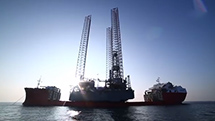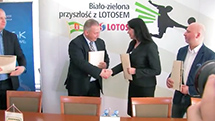7. Accounting policies
These consolidated financial statements have been prepared in accordance with the historical cost principle, except with respect to financial instruments, which are measured at fair value.
The key accounting policies applied by the Group are presented below.
7.1 Basis of consolidation
These consolidated financial statements have been prepared on the basis of the financial statements of the Parent and financial statements of its subsidiaries, jointly-controlled entities and associates, prepared as at December 31st 2013.
All significant balances and transactions between the related entities, including material unrealised profits on transactions, have been eliminated in their entirety. Unrealised losses are eliminated unless they are indicative of impairment.
Subsidiaries are fully consolidated starting from the date when the Group assumes control over them and cease to be consolidated when the control is lost. The Company is deemed to exert control when it holds, directly or through its subsidiaries, more than 50% of the votes in a given entity, unless it is possible to prove that the ownership of over 50% of the votes is not tantamount to exerting control. The Company’s ability to decide on an entity's financial and operational policies, even where it does not hold the majority of votes in that entity, is also deemed exerting control. As at the end of the reporting period, the Company held shares in an equity-accounted jointly-controlled entity.
7.2 Revenue
Revenue is disclosed at the fair value of consideration received or due for the sale of products, merchandise and services, executed in the ordinary course of business, less discounts, value added tax (VAT) and other sales-related taxes (excise duty, fuel charge). Revenue from sale of products and merchandise is recognised at the moment of delivery, when material risk and benefits resulting from the ownership of the products and merchandise have been transferred to the purchaser.
7.3 Dividend income
Dividend is recognised as finance income as at the date on which the appropriate governing body of the dividend payer adopts a resolution concerning distribution of profit, unless the resolution specifies another dividend record date.
7.4 Interest income
Interest income is recognised as the interest accrues (using the effective interest rate), unless its receipt is doubtful.
7.5 Taxes
7.5.1 Income tax
Mandatory decrease in profit/(increase in loss) comprises: current income tax (CIT) and deferred income tax. The current portion of income tax is calculated based on net profit/(loss) (taxable income) for a given financial year. Net profit (loss) for tax purposes differs from net profit (loss) for accounting purposes due to temporary differences between revenue amounts calculated for these two purposes, including income which is taxable and costs which are tax-deductible in a period other than the current accounting period, as well as permanent differences attributable to income and cost which will never be accounted for in tax settlements. Tax charges are calculated based on the tax rates effective for a given financial year.
For the purposes of financial reporting, the Group recognises deferred tax liabilities using the balance-sheet liability method in relation to all temporary differences existing as at the end of the reporting period between the tax base of assets and liabilities and their carrying amounts disclosed in the consolidated financial statements.
Deferred tax liability is recognised for all taxable temporary differences:
- except to the extent that the deferred tax liability arises from the initial recognition of goodwill or the initial recognition of an asset or liability in a transaction which is not a business combination, and, at the time of the transaction, affects neither accounting pre-tax profit nor taxable profit (tax loss), and
- in the case of taxable temporary differences associated with investments in subsidiaries, jointly-controlled entities or associates and interests in joint ventures, unless the investor is able to control the timing of the reversal of the temporary differences and it is probable that the temporary differences will not reverse in the foreseeable future.
Deferred tax assets are disclosed in relation to all deductible temporary differences, unused tax assets, and unused tax losses brought forward in the amount of the probable taxable income which would enable these differences, assets and losses to be used:
- except to the extent that the deferred tax assets related to deductible temporary differences arise from the initial recognition of an asset or liability in a transaction which is not a business combination, and, at the time of the transaction, affects neither accounting pre-tax profit nor taxable income (tax loss), and
- in the case of deductible temporary differences associated with investments in subsidiaries, jointly-controlled entities or associates and interests in joint ventures, the related deferred tax assets are recognised in the statement of financial position to the extent it is probable that in the foreseeable future the temporary differences will be reversed and taxable income will be generated which will enable the deductible temporary differences to be offset.
The carrying amount of deferred tax assets is revised as at the end of each reporting period and is subject to appropriate reduction to the extent it is no longer probable that taxable income sufficient for its partial or full realisation would be generated.
Deferred tax assets and deferred tax liabilities are calculated using tax rates expected to be effective at the time of realisation of particular asset or liability, based on tax rates (and tax legislation) effective as at the end of the reporting period or tax rates (and tax legislation) which as at the end of the reporting period are certain to be effective in the future. The effect of deferred tax on items posted directly to equity is recognised in equity through other comprehensive income.
Deferred tax assets and deferred tax liabilities are presented in the statement of financial position in the amount obtained after they are offset for particular entities consolidated by the Company.
7.5.2 Value-added tax (VAT), excise duty and fuel charge
Revenue, expenses, assets and liabilities are recognised net of value-added tax, excise duty and fuel charge:
- except where the value-added tax (VAT) paid on the purchase of assets or services is not recoverable from the tax authorities (in such a case it is recognised in the cost of a given asset or as part of the cost item), and
- except in the case of receivables and payables which are recognised inclusive of the value-added tax (VAT), excise duty and fuel charge.
The net amount of the value-added tax (VAT), excise duty and fuel charge which is recoverable from or payable to tax authorities is carried in the statement of financial position under receivables or liabilities, as appropriate.
7.6 Foreign currency transactions
Business transactions denominated in foreign currencies are reported in the consolidated financial statements after translation into the Group's presentation currency (Polish złoty) at the following exchange rates:
- the exchange rate actually applied on that date due to the nature of the transaction – in the case of sale or purchase of foreign currencies;
- the mid rate quoted for a given currency by the National Bank of Poland (the “NBP”) for the day immediately preceding the transaction date – in the case of payment of receivables or liabilities where there is no rationale for using the exchange rate referred to above, and for other transactions.
The exchange rate applicable to purchase invoices is the mid rate quoted by the National Bank of Poland for the last business day immediately preceding the invoice date, and the exchange rate applicable to sales invoices is the mid rate quoted by the National Bank of Poland for the last business day immediately preceding the date of sale.
Any foreign exchange gains or losses resulting from currency translation (including intra-Group foreign currency transactions) are posted to the statement of comprehensive income, except for foreign exchange gains and losses which are treated as a part of borrowing costs and are capitalised in property, plant and equipment (foreign exchange gains and losses on interest and fees and commissions). Non-monetary items measured at historical cost in a foreign currency are translated at the exchange rate effective as at the date of the initial transaction. Non-monetary items measured at fair value in a foreign currency are translated at the exchange rate effective as at the date of determining the fair value.
The Company calculates realised and unrealised foreign exchange gains (losses) separately and recognises the resulting total balance in the statement of comprehensive income under:
- operating profit or loss: in the case of foreign exchange gains and losses related to settlement of trade receivables and payables,
- finance gain or loss: in the case of borrowings, investment commitments, and cash and cash equivalents.
Exchange differences on valuation as at the end of the reporting period of short-term investments (e.g. shares and other securities, loans advanced, cash and cash equivalents) and receivables and liabilities denominated in foreign currencies are charged to finance income or costs and operating income or expenses.
The financial statements of foreign entities are translated into the presentation currency of the consolidated financial statements at the following exchange rates:
- items of the statement of financial position – at the mid rate quoted by the National Bank of Poland for the end of the reporting period (mid rate quoted by the NBP for the end of the reporting period),
- items of the statement of comprehensive income – at the exchange rate computed as the arithmetic mean of mid rates quoted by the National Bank of Poland for the end of each month in the reporting period (NBP's average mid rate in the reporting period).
The resulting exchange differences are recognised in equity and other comprehensive income as a separate component.
Exchange differences arising on a monetary item that forms a part of a reporting entity's net investment in a foreign operation are recognised in equity and other comprehensive income, and on disposal of the investment they are reclassified to consolidated profit or loss in the statement of comprehensive income.
At the time of disposal of a foreign entity, the accumulated exchange differences recognised in equity and relating to this foreign entity are disclosed in profit or loss.
Goodwill and fair value adjustments arising on the acquisition of a foreign operation are treated as assets or liabilities of the foreign operation and are translated into the presentation currency of the financial statements at the exchange rate effective for the end of the reporting period.
The following exchange rates were used in the valuation of items of the statement of financial position:
| NBP’s mid-exchange rate quoted for: | Dec 31 2013 (1) | Dec 31 2012 (2) |
|---|---|---|
| USD | 3.0120 | 3.0996 |
| EUR | 4.1472 | 4.0882 |
| NOK | 0.4953 | 0.5552 |
| LTL | 1.2011 | 1.1840 |
(1) Mid-exchange rates table, effective for December 31st 2013.
(2) Mid-exchange rates table, effective for December 31st 2012.
The following exchange rates were used in the valuation of items of the statement of comprehensive income:
| NBP's average exchange rate for the reporting period | ended Dec 31 2013 (1) | ended Dec 31 2012 (2) |
|---|---|---|
| USD | 3.1653 | 3.2312 |
| EUR | 4.2110 | 4.1736 |
| NOK | 0.5357 | 0.5594 |
| LTL | 1.2196 | 1.2087 |
(1) Based on the arithmetic mean of the mid rates quoted by the NBP for the last day of each full month in the period January 1st–December 31st 2013.
(2) Based on the arithmetic mean of the mid rates quoted by the NBP for the last day of each full month in the period January 1st–December 31st 2012.
7.7 Property, plant and equipment
Items of property, plant and equipment other than land are measured at cost less accumulated depreciation and impairment losses.
Land is measured at cost less impairment losses. In the case of perpetual usufruct rights to land, cost is understood to mean the amount paid for the right to a third party.
Perpetual usufruct rights to land obtained free of charge are capitalised at fair value in the accounting books.
Initial value of an item of property, plant and equipment comprises its cost, which includes all costs directly related to its acquisition and bringing it to working condition for its intended use. The cost also includes the cost of replacing component parts of plant and equipment, which is recognised when incurred, if relevant recognition criteria are fulfilled. Costs incurred on an asset which is already in service, such as costs of repairs or overhauls or operating fees, are expensed in the reporting period in which they were incurred.
Items of property, plant and equipment (including their components), other than land and property, plant and equipment used for crude oil production, are depreciated using the straight-line method over their estimated useful lives, which are as follows:
| Buildings and structures | over 1 year – 80 years |
| Plant and equipment | over 1 year – 25 years |
| Vehicles and other | over 1 year – 15 years |
Items of property, plant and equipment used in crude oil and gas production are depreciated using the units-of-production depreciation method, i.e. depreciation per unit of production is charged to expenses. The depreciation rate is estimated by reference to forecasts of crude oil production from a given geological area. If the estimated hydrocarbon reserves (in 2P category – proved and probable reserves) change significantly as at the end of the reporting period, depreciation per unit of produced crude oil is remeasured. Then, starting from the new financial year, the revised depreciation rate is applied.
An item of property, plant and equipment may be removed from the statement of financial position if it is sold or if the company does not expect to realise any economic benefits from its further use. Any gains or losses on derecognition of an asset from the statement of financial position (calculated as the difference between net proceeds from its sale, if any, and the carrying amount of the asset) are disclosed in the statement of comprehensive income in the period of derecognition.
The residual value, useful economic life and depreciation method are reviewed on an annual basis and adjusted – if required – with effect from the beginning of the next financial year.
In its consolidated financial statements, under property, plant and equipment the Group discloses assets corresponding to the value of provision for decommissioning of oil and gas facilities. The assets were recognised in accordance with IAS 16 Property, Plant and Equipment, which reads: “The cost of an item of property, land and equipment comprises […] the initial estimate of the costs of dismantling and removing the item and restoring the site on which it is located, the obligation for which an entity incurs when the item is acquired or as a consequence of having used the item during a particular period for purposes other than to produce inventories during that period”. The Group’s obligation to incur costs of decommissioning of the oil and gas extraction facilities results directly from the reasons specified in IAS 16 Property, Plant and Equipment. Under paragraph 63 of the standard, the entities applying the IAS are obliged to test the value of the asset periodically, at least as at the end of the reporting period.
Revaluation of assets so recognised may be caused by:
- change in estimated cash outflow necessary to ensure performance of the decommissioning obligation,
- change in the current market discount rate,
- change in the inflation rate.
Items of property, plant and equipment under construction are measured at the amount of aggregate costs directly attributable to their acquisition or production (including finance costs) less impairment losses, if any. Items of property, plant and equipment under construction are not depreciated until they are ready for their intended use.
Property, plant and equipment under construction (including assembly) are recognised at cost.
Finance costs capitalised in property, plant and equipment under construction include their costs, in line with the policies described in Note 7.22.
Cost of exploration for crude oil and natural gas is capitalised as property, plant and equipment under construction until the deposit volume and the economic viability of production are determined. Upon confirmation of the existence of reserves whose extraction is technically and economically viable, the expenditure incurred on exploration is transferred to property, plant and equipment and is subsequently depreciated. If exploration drillings do not result in discovery of any reserves whose extraction is technically and economically viable, impairment losses on property, plant and equipment under construction are recognised and charged to profit or loss of the period in which it is found that commercial production from the discovered deposits is not viable.
7.8 Goodwill
The acquirer recognises the aquiree’s goodwill on acquisition, equal to the excess of the difference between (A) the amount of consideration transferred, measured at its acquisition-date fair value, including the value of any non-controlling interests in the acquiree, (B) the acquisition-date fair value of the acquirer’s previously held equity interest in the acquiree (in the case of a business combination achieved in stages), and (C) the net of the acquisition-date amount, including all identifiable assets acquired and the liabilities assumed, measured at fair values as at the transaction date.
Goodwill = (C) - (A) - (B)
In the case of a business combination achieved in stages, the acquirer remeasures its previously held equity interest in the acquiree at its acquisition-date fair value and recognises the resulting gain or loss in the statement of comprehensive income.
Following the initial recognition, goodwill is carried at cost less cumulative impairment losses. Goodwill is tested for impairment once a year. It is not amortised.
As at the date of assuming control, the acquired goodwill is allocated to every identifiable cash-generating unit. The Group calculates impairment of value by estimating the recoverable amount of the cash-generating unit relevant to a given part of goodwill. If the recoverable amount of a cash-generating unit is lower than its carrying amount, the Group recognises an impairment loss. If goodwill comprises a part of a cash-generating unit and the Group sells a part of the cash-generating unit's business, the goodwill pertaining to the sold business is included in the carrying amount of the sold business for the purpose of calculating gains or losses on disposal of the part of business. In such a case, goodwill pertaining to the sold business should be measured using the relative value of the sold business, pro-rata to the interest in the retained part of the cash-generating unit.
7.9 Other intangible assets
Intangible assets other than goodwill comprise licences for production and exploration of crude oil in Lithuania purchased as part of a business combination, expenditure incurred on gas and oil exploration licences on the Norwegian Continental Shelf, other production and exploration licences, software licences, patents, trademarks and acquired CO2 emission allowances. Intangible assets are initially recognised at cost, if they are acquired in separate transactions. Intangible assets acquired as part of a business combination are recognised at fair value as at the transaction date. Subsequent to initial recognition, measurement of intangible assets accounts for accumulated amortisation and impairment losses.
Lithuanian licences obtained during the step acquisition of AB LOTOS Geonafta Group companies are amortised using the unit-of-production method, i.e. amortisation per unit of produced crude oil is charged to expenses. The amortisation rate is estimated by reference to forecasts of crude oil production from a given field. If the estimated hydrocarbon reserves (in 2P category – proved and probable reserves) change significantly as at the end of the reporting period, amortisation per unit of produced crude oil is remeasured. Then, starting from the new financial year, the revised amortisation rate is applied.
Expenditure on exploration licences on the Norwegian Continental Shelf is not amortised until the technical feasibility and commercial viability of extraction is demonstrated. Accounting policy for exploration and evaluation expenditure is presented below.
Other intangible assets are amortised using the straight-line method over their estimated useful lives. The expected useful lives of the Group’s intangible assets range from 2 to 40 years.
The amortisation period and the amortisation method for an intangible asset are reviewed at the end of each financial year. Changes in the expected useful life or pattern of generation of the future economic benefits embodied in an intangible asset are reflected by changing the amortisation period or amortisation method, as appropriate, and are treated as changes in accounting estimates.
Except capitalised development expenditure, expenditure on intangible assets produced by the Company is not capitalised but is charged to expenses in the period in which it was incurred.
7.10 Mineral resources exploration and evaluation expenditures
Exploration for and evaluation (appraisal) of mineral resources means the search for crude oil, natural gas and similar non-regenerative resources and determination of the technical feasibility and commercial viability of extracting a mineral resource.
From the moment of obtaining the exploration right to a given area to the moment of determination of the technical feasibility and commercial viability of extracting a mineral resource, expenditure directly connected with exploration for and evaluation of oil and gas resources is recognised as an exploration and evaluation asset.
The expenditure includes the costs of acquisition of exploration rights, costs of the exploration rig, salaries and wages, consumables and fuel, insurance, costs of geological and geophysical surveys, as well as costs of other services.
The Group classifies the exploration and evaluation assets as property, plant and equipment or intangible assets, depending on the type of the acquired assets, and applies this classification policy in a consistent manner.
Once the size of a deposit is confirmed and its production plan is approved, the expenditure is transferred to appropriate items of intangible assets or property, plant and equipment.
The Group examines the need to recognise impairment losses on exploration and evaluation assets in relation to a specific area by considering the following:
- the period for which the Group has the right to explore in the specific area has expired during the current financial year or will expire in the near future, and is not expected to be renewed,
- no substantial expenditure on further exploration for and appraisal of mineral resources is anticipated,
- exploration for and appraisal of mineral resources have not led to discovery of commercially viable quantities of mineral resources and the Group has decided to discontinue such activities,
- sufficient data exist to indicate that, although development in the specific area is likely to proceed, the carrying amount of the exploration and evaluation asset is unlikely to be recovered in full from successful development or by sale.
7.11 Equity-accounted and proportionately-consolidated entities
Equity-accounted entities
Investments in equity-accounted entities are recognised in the statement of financial position at cost, adjusted for subsequent changes in the Group’s share in net assets of the entities, less impairment losses, if any. The statement of comprehensive income reflects the share in the results of operations of such entities, and if a change is recognised directly in their equity, the Group recognises its share in each change and, if applicable, discloses it in the statement of changes in equity.
Proportionate consolidation
All assets, liabilities, revenue and expenses of an entity subject to proportionate consolidation are individually aggregated with the corresponding items in the financial statements, in accordance with the Group's share in the entity's net assets. The Group ceases to apply proportionate consolidation after it ceases to exercise joint control over the entity.
For the list of equity-accounted and proportionately-consolidated entities, see Note 2.
7.12 Leases
A lease is classified as a finance lease if it transfers substantially all the risks and rewards incidental to ownership of the leased asset onto the lessee. All other types of leases are treated by the Group as operating leases.
The Group as a lessor
Finance leases are disclosed in the statement of financial position as receivables, at amounts equal to the net investment in the lease less the principal component of lease payments for a given financial year calculated based on a pattern reflecting a constant periodic rate of return on the lessor's net investment outstanding in respect of the finance lease.
Finance income from interest on a finance lease is disclosed in the relevant reporting periods based on a pattern reflecting a constant periodic rate of return on the net investment outstanding in respect of the finance lease.
Income from operating leases is recognised in the statement of comprehensive income on a straight-line basis over the lease term.
The Group as a lessee
Assets used under a finance lease are recognised as assets of the Group and are measured at fair value as at the acquisition date or, if lower, the present value of the minimum lease payments. The resultant obligation towards the lessor is presented in the statement of financial position under Finance lease liabilities. Lease payments are broken down into the interest component and the principal component so as to produce a constant rate of interest on the remaining balance of the liability. Finance costs are recognised in the statement of comprehensive income.
Operating lease payments are recognised in the statement of comprehensive income on a straight-line basis over the lease term.
7.13 Impairment of non-financial non-current assets
As at the end of the reporting period, the Group assesses whether there is an indication of impairment of any of its assets. If the Group finds that there is such indication, or if the Group is required to perform annual impairment tests, the Group estimates the recoverable amount of a given asset.
The recoverable amount of an asset is equal to the higher of:
- the fair value of the asset or cash generating unit in which such asset is used, less cost to sell, or
- the value in use of the asset or cash generating unit in which such asset is used.
The recoverable amount is determined for the individual assets, unless a given asset does not generate separate cash flows largely independent from those generated by other assets or asset groups. If the carrying amount of an asset is higher than its recoverable amount, the value of the asset is impaired and an impairment loss is recognised up to the established recoverable amount.
In assessing value in use, the projected cash flows are discounted to their present value (at a pre-tax discount rate) which reflects current market assessments of the time value of money and the risks specific to the asset. Any impairment losses on non-financial assets used in operations are recognised under other expenses.
As at the end the reporting period, the Group assesses whether there is an indication that any impairment loss recognised in the previous periods with respect to a given asset should be reduced or reversed in full. If there is such indication, the Group again estimates the recoverable amount of the asset and the recognised impairment loss is reversed accordingly only if following the recognition of the most recent impairment loss there has been a change in the estimates used to determine the recoverable amount of the asset. In such a case, the carrying amount of the asset is increased up to its recoverable amount. The increased value may not exceed the carrying amount of the asset that would have been determined (net of accumulated amortisation/depreciation) if no impairment losses had been recognised on that asset in the previous years. Reversal of an impairment loss on a non-financial non-current assets is immediately recognised as Other income. Following reversal of an impairment loss, in the subsequent periods the amortisation/depreciation charge related to a given asset is adjusted so that over the remaining useful life of that asset its revised carrying amount, less its residual value, can be regularly written off. The Group offsets corresponding items of other income and expenses in accordance with IAS 1 Presentation of Financial Statements (Section 34) and recognises them in the statement of comprehensive income on a net basis.
7.14 Inventories
Inventories are stated at the lower of cost and net realisable value.
Costs incurred in order to bring each inventory item to its present location and condition are accounted for in the following manner:
- materials and merchandise – at cost,
- finished goods and work-in-progress – at the cost of direct materials and labour and an appropriate portion of indirect production costs, established on the basis of normal capacity utilisation.
Net realisable value is the selling price estimated as at the end of the reporting period, net of value added tax, excise duty and fuel charge, less any rebates, discounts and other similar items, and less the estimated costs to complete and costs to sell.
Decrease in inventories is established with the weighted average method.
Mandatory stocks are disclosed as current assets given their short turnover cycle. For more information on mandatory stocks, see Note 19.2.
7.15 Investment property
Investment property is measured at cost less accumulated depreciation and impairment losses.
Investment property, including investments in land, perpetual usufruct of land, buildings and structures, include property which the Group does not use for its own purposes but which will generate benefits in the form of value appreciation or rent income.
7.16 Trade and other receivables, prepayments and accrued income
Trade receivables, which typically become due and payable in 7 to 60 days, are recognised and carried at amounts initially invoiced, less impairment losses on doubtful receivables. Impairment losses on receivables are estimated when the collection of the full amount of receivables is no longer probable. Uncollectible receivables are written off through the statement of comprehensive income when recognised as unrecoverable accounts.
If the effect of time value of money is significant, the value of receivables is determined by discounting the projected future cash flows to their present value at a pre-tax discount rate reflecting the current market estimates of the time value of money. If the discount method is applied, an increase in receivables over time is recognised as finance income.
The Group recognises prepayments where costs relate to future reporting periods; prepayments are recognised under other non-financial assets.
7.17 Cash and cash equivalents
Cash in hand and at banks, as well as short-term deposits held to maturity are measured at face value.
Cash and cash equivalents disclosed in the consolidated statement of cash flows comprise cash in hand, overdraft facilities as well as those bank deposits maturing within three months which are not treated as investment placements.
7.18 Assets held for sale
Non-current assets (or disposal groups) are classified as held for sale if their carrying amounts will be recovered principally through a sale transaction rather than through continuing use. This condition is deemed to be met only if the sale is highly probable and the asset (or disposal group) is available for immediate sale in its present condition. Classification of an asset as held for sale means that the management intends to complete the sale within one year from the change of its classification.
Non-current assets and disposal groups classified as held for sale are measured at the lower of their carrying amount and fair value less costs to sell.
7.19 Equity
Equity is recognised in the consolidated financial statements by categories, in accordance with applicable laws and constitutional documents of the consolidated entities.
The share capital of the LOTOS Group is the share capital of the Parent and is recognised at its par value, in the amount specified in the Company’s Articles of Association and in the relevant entry in the National Court Register.
7.20 Borrowings and other debt instruments
All borrowings and other debt instruments are initially recognised at cost, equal to the fair value, less cost of obtaining the funds.
Following initial recognition, borrowings and other debt instruments are measured at amortised cost, using the effective interest rate method. Amortised cost includes the cost of obtaining the funds as well as discounts or premiums obtained at settlement of the liability. Upon removal of the liability from the statement of financial position or recognition of impairment loss, gains or losses are recognised in the statement of comprehensive income.
7.21 Employee benefit obligations
7.21.1 Retirement severance payments, length-of-service awards and other employee benefits
In accordance with the Collective Bargaining Agreement, the Group's employees are entitled to length-of-service awards and severance payments upon retirement due to old age or disability, as well as death benefits.
Also, the employees, retired employees, and pensioners covered by the Group's social benefits are entitled to benefits from a separate social fund, which is established pursuant to applicable national regulations (Company Social Benefits Fund).
According to IAS 19 Employee Benefits, old-age and disability retirement severance payments, as well as contributions to the Company Social Benefits Fund to be used for payment of future benefits to retired employees, are classified as defined post-employment benefit plans, while length-of-service awards, death benefits, and benefits paid to currently retired employees are recognised under other employee benefits. Present value of future post-employment benefit obligations as at the end of the reporting period is calculated by an independent actuary using the projected unit credit method and is a discounted value of future payments, which the employer has to make in order to fulfil its obligations under the work performed by employees in previous periods (until the end of the reporting period), defined individually for each employee, accounting for employee turnover (probability of employees leaving work), without including future employees.
In prior years, the value of future employee benefit obligations included length-of-service awards, old-age and disability retirement severance payments, and social fund benefits payable to retired employees and pensioners. The value as at December 31st 2013 additionally includes the estimated value of death benefits, due to the increased importance of that item in the actuarial estimates.
Length-of-service awards are paid after a specific period of employment. Old-age and disability retirement severance payments are one-off and paid upon retirement. Amounts of severance payments and length-of-service awards depend on the length of employment and the average remuneration of an employee. The amount of death benefit depends on the length of employment of the deceased employee, and the benefit is payable to the family, in accordance with the rules set forth in the Polish Labour Code.
Following the amendments to IAS 19 applicable for annual periods beginning after January 1st 2013, the Group changed the presentation of actuarial gains or losses under post-employment employee benefits in its statement of comprehensive income. For annual periods beginning after January 1st 2013, the actuarial gains or losses are recognised in other comprehensive income rather than in operating profit/loss as was the case earlier. In accordance with the provisions of the amended standard, the Group applied these rules retrospectively by adjusting the comparative data. These changes, reflected in Retained earnings, had no effect on the presentation in the statement of financial position or in the statement of changes in equity, and their impact on the statement of comprehensive income was immaterial. For detailed information about changes in the comparative data in the statement of comprehensive income see Note 6.
Employees of the Group companies are also entitled to holidays in accordance with the rules set forth in the Polish Labour Code. The Group calculates the cost of employee holidays on an accrual basis using the liability method. The value of compensation for unused holidays is recognised in the Group's accounting records based on the difference between the balance of holidays actually used and the balance of holidays used established proportionately to the passage of time, and disclosed in the financial statements as, respectively, current or non-current liabilities under other employee benefits during employment.
Obligations under other employee benefits during employment also comprise bonuses and awards granted as part of the Group's incentive pay systems.
For detailed information on employee benefits, see Note 29, containing the individual items of employee benefit obligations and costs, actuarial assumptions, as well as an analysis of sensitivity of estimates to changes of these assumptions. The Group recognises the cost of discount on its employee benefit obligations in finance costs. Given the different nature of pension plans operated by the Group's foreign companies – LOTOS Exploration and Production Norge AS and the companies of the AB LOTOS Geonafta Group – and their negligible effect on the Group's obligations under length-of-service awards and post-employment benefits, such companies' obligations are presented separately as Obligations under length-of-service awards and post-employment benefits at foreign companies.
7.21.2 Profit distribution for employee benefits and special accounts
According to the business practice in Poland, company shareholders have the right to allocate a part of profit for employee benefits by making contributions to the company social benefits fund and to other special accounts. In the financial statements, such distributions are charged to operating expenses in the period to which the profit distribution relates.
7.22 Borrowing costs
Borrowing costs (i.e. interest and other costs incurred in connection with borrowings) are expensed in the period in which they were incurred, except costs which relate directly to the acquisition, construction or production of an asset being completed (including foreign exchange losses on interest and fees and commissions), which are capitalised as part of the cost of such asset (an asset being completed is an asset whose preparation for use or sale requires a significant amount of time).
To the extent that funds are borrowed specifically for the purpose of acquiring the asset being completed, the amount of the borrowing costs which may be capitalised as part of such asset is determined as the difference between the actual borrowing costs incurred in connection with a given credit facility or loan in a given period and the proceeds from temporary investments of the borrowed funds.
To the extent that funds are borrowed without a specific purpose and are later allocated for the acquisition of an asset being completed, the amount of the borrowing costs which may be capitalised is determined by applying the capitalisation rate to the expenditure on that asset.
7.23 Financial assets and liabilities
Financial assets and liabilities are classified into the following categories:
- Financial assets held to maturity,
- Financial assets and liabilities at fair value through profit or loss,
- Loans and receivables,
- Financial assets available for sale,
- Financial liabilities at amortised cost.
Financial assets held to maturity
are non-derivative financial assets with fixed or determinable payments and fixed maturities, which are quoted on an active market and which the Group has the positive intention and ability to hold to maturity, other than those:
- designated at fair value through profit or loss upon initial recognition,
- designated as available for sale,
- which qualify as loans and receivables.
Financial assets held to maturity are measured at amortised cost using the effective interest method.
Financial assets held to maturity are classified as non-current assets if they mature more than 12 months after the end of the reporting period.
Financial assets and liabilities at fair value through profit or loss
A financial asset at fair value through profit or loss is a financial asset that meets either of the following conditions:
a) it is classified as held for trading. Financial assets are classified as held for trading if they:
- have been acquired principally for the purpose of being sold in the near future,
- are part of a portfolio of identified financial instruments that are managed together and for which there is probability of profit-taking in the near future,
- are derivative financial instruments (except for those which are part of hedge accounting or financial guarantee contracts),
b) it has been assigned to this category in accordance with IAS 39 Financial Instruments: Recognition and Measurement upon initial recognition.
Measurement of financial assets at fair value through profit or loss consists in recognition of such assets at fair value by reference to their market value as at the end of the reporting period, without reflecting sale transaction costs. Any changes in the value of such instruments are recognised in the statement of comprehensive income as finance income or costs.
An entire contract can be designated as a financial asset at fair value through profit or loss if it contains one or more embedded derivatives. The above does not apply when an embedded derivative has no significant impact on the cash flows generated under the contract or when it is clear that if a similar hybrid instrument was first considered, separation of the embedded derivative would be prohibited under IFRS.
Financial assets may be designated as financial assets at fair value through profit or loss on initial recognition if the following criteria are met:
- (i) such designation eliminates or significantly reduces a measurement or recognition inconsistency (an accounting mismatch); or
- the assets are part of a group of financial assets that are managed and measured based on fair value, according to a well-documented risk management strategy; or
- (iii) the assets contain embedded derivatives which should be presented separately.
Financial liabilities at fair value through profit or loss include financial liabilities held for trading, and financial liabilities initially designated as financial liabilities at fair value through profit or loss. Financial liabilities are classified as held for trading if they were acquired for the purpose of being sold in the near future. Derivative financial instruments, including separated embedded instruments, are also classified as held for trading, unless they are considered as effective hedges.
Financial liabilities may be designated as financial liabilities at fair value through profit or loss on initial recognition if the following criteria are met:
- (i) such designation eliminates or significantly reduces a measurement or recognition inconsistency that would otherwise arise from measuring assets or liabilities or recognising the gains and losses on them on different base
- (ii) the liabilities are part of a group of financial liabilities that are managed and measured based on fair value, according to a well-documented risk management strategy, or
- (iii) the financial liabilities contain embedded derivative instruments which should be presented separately.
Financial liabilities at fair value through profit or loss are measured at fair value, based on their market value as at the end of the reporting period, without reflecting sale transaction costs. Changes in the fair value of such instruments are recognised in profit or loss as finance income or costs.
Based on the fair value measurement methods applied, the Group classifies its individual financial assets and liabilities according to the following levels (fair value hierarchy):
- Level 1: Financial assets and liabilities whose fair values are measured directly on the basis of quoted prices (used without adjustment) from active markets for identical assets or liabilities.
- Level 2: Financial assets and liabilities whose fair values are measured using measurement models when all significant input data is observable on the market either directly (unadjusted market prices) or indirectly (data based on market prices).
- Level 3: Financial assets and liabilities whose fair values are measured using measurement models when the input data is not based on observable market data (unobservable input data).
The Group discloses derivative transactions with positive fair values under financial assets held for trading. Derivative transactions with negative fair values are disclosed under financial liabilities held for trading.
The Group's financial assets and liabilities held for trading include the following types of derivatives: options, forward contracts (in particular forward rate agreements), futures contracts, swaps (in particular interest-rate swaps) and spot contracts. All the above types of forward transactions classified as derivatives are executed by the Group as part of its risk management policy (see below).
Fair value of commodity swaps is established by reference to future cash flows connected with the transactions, calculated on the basis of the difference between the average market price and the transaction price. The fair value is established on the basis of prices quoted on active markets, as provided by an external consultancy. (Level 2 in the fair value hierarchy).
Fair value of spots, forwards and currency swaps is established by reference to future discounted cash flows from the transactions, calculated on the basis of the difference between the forward rate and the transaction price. The forward rate is calculated on the basis of the fixing rate quotations of the National Bank of Poland and the interest rate curve implied in FX swaps (Level 2 in the fair value hierarchy).
Fair value of FRAs is established by reference to future discounted cash flows from the transactions, calculated on the basis of the difference between the forward rate and the transaction price. The forward rate is calculated using the zero-coupon interest rate curve based on 6M or 3M LIBOR, depending on the type of transaction (Level 2 in the fair value hierarchy).
As part of its risk management activities the Group evaluates the risk of deficit of free emission allowances allocated under carbon dioxide emission reducing programme Note 5 and manages the risk of emission allowances prices quoted in an active market.
To hedge against the risk associated with CO2 emission allowances prices, the Group enters into EUA, CER and ERU futures contracts The estimated fair value of these instruments is based on the difference between the market price of a contract as quoted at the valuation date by the Intercontinental Exchange (ICE). (Level 1 in the fair value hierarchy).
If required, futures contracts to purchase carbon (CO2) allowances open as at the last day of the reporting period are settled by the Group through physical delivery, with the intention to potentially use the allowances to offset the Group's actual CO2 emissions. Valuation of transactions to be settled through physical delivery is not disclosed under financial assets/liabilities in the financial statements. However, the Group internally monitors and performs the valuation of its open futures positions as part of an overall assessment of efficiency of its CO2 risk management (off balance sheet).
Information on the Group’s limits of free carbon dioxide emission allowances are disclosed in Note 34, and a description of risk management in Note 32.2.
The Group applies hedge accounting. Changes in the fair value of financial derivatives designated to hedge cash flows, to the extent representing an effective hedge, are posted directly to other comprehensive income.
In the statement of financial position, financial derivatives are recognised under a separate item or, if their value is immaterial, under other assets and liabilities.
For more information on recognition and measurement of financial derivatives and hedge accounting, see Notes 7.25 i 7.26.
Loans and receivables
The category includes financial assets with fixed or determinable payments not classified as derivatives and not traded on any active market. They are disclosed under current assets if they mature within 12 months from the end of the reporting period. Loans and receivables with maturities exceeding 12 months from the end of the reporting period are classified as non-current assets.
The category includes: trade receivables, cash and cash equivalents, deposits, security deposits, loans advanced, investment receivables, cash pool receivables, and other. In the statement of financial position, these are recognised under: Trade receivables, Cash and cash equivalents, Other current and non-current assets. For information on their recognition and measurement, see Notes 7.12, 7.16 and 7.17.
Financial assets available for sale
Financial assets available for sale are recognised at fair value increased by the transaction costs which may be directly attributed to an acquisition or issue of a financial asset. If quoted market prices from an active market are not available and the fair value cannot be reliably measured using alternative methods, available-for-sale financial assets are measured at cost less impairment. The positive or negative differences between the fair value of available-for-sale financial assets (if they have a market price derived from an active market or their fair value can be established in any other reliable manner) and their cost are recognised net of deferred tax in other comprehensive income. Impairment losses on available-for-sale financial assets are recognised in finance costs.
Any purchase or sale of financial assets is recognised at the transaction date. On initial recognition, financial assets are recognised at fair value including – in the case of financial assets other than those at fair value through profit or loss – transaction costs directly attributable to the purchase.
A financial asset is removed from the statement of financial position when the Group loses control over the contractual rights embodied in the financial instrument. This usually takes place when the instrument is sold or when all cash flows generated by the instrument are transferred to a non-related third party.
This category includes shares in other entities which are recognised by the Group in the statement of financial position under Other financial assets.
Financial liabilities at amortised cost
Financial liabilities, not classified as financial liabilities at fair value through profit or loss, are carried at amortised cost using the effective interest rate method.
Financial liabilities at amortised cost include borrowings, other debt instruments, finance lease liabilities, trade payables, investment commitments, and other liabilities. These liabilities are recognised in the statement of financial position under: Borrowings, other debt instruments and finance lease liabilities, Trade payables, Other liabilities and provisions. For information on recognition and measurement of the above classes in this category of instruments, see Notes 7.12, 7.20 and 7.26.
7.24 Impairment of financial assets
As at the end of the reporting period the Group determines whether there is an objective indication of impairment of a financial asset or a group of financial assets.
Assets carried at amortised cost
If there is an objective indication that the value of loans and receivables measured at amortised cost has been impaired, the impairment loss is recognised in the amount equal to the difference between the carrying amount of the financial asset and the present value of estimated future cash flows (excluding future losses relating to irrecoverable receivables, which have not yet been incurred), discounted at the initial effective interest rate (i.e. the interest rate used at the time of initial recognition). The carrying amount of an asset is reduced directly or by recognising relevant provisions. The amount of loss is recognised in the statement of comprehensive income.
The Group first determines whether there exists an objective indication of impairment with respect to each financial asset that is deemed material, and with respect to financial assets that are not deemed material individually. If the analysis shows that there exists no objective indication of impairment of an individually tested asset, regardless of whether it is material or not, the Group includes the asset into the group of financial assets with similar credit risk profile and tests such group for impairment as a whole. Assets which are tested for impairment individually, and with respect to which an impairment loss has been recognised or a previously recognised loss is deemed to remain unchanged, are not taken into account when a group of assets are jointly tested for impairment.
If an impairment loss decreases in the next period, and the decrease may be objectively associated with an event that occurred subsequent to the impairment loss recognition, the recognised impairment loss is reversed. The subsequent reversal of an impairment loss is recognised in the statement of comprehensive income to the extent that the carrying amount of the asset does not exceed its amortised cost as at the reversal date.
Financial assets carried at cost
If there exists an objective indication of impairment of a non-traded equity instrument which is not carried at fair value since such value cannot be reliably determined, or of a related derivative instrument which must be settled by delivery of such non-traded equity instrument, the amount of impairment loss is established as the difference between the carrying amount of the financial asset and the present value of estimated future cash flows discounted with the market rate applicable to similar financial assets prevailing at a given time.
Financial assets available for sale
If there exists an objective indication of impairment of a financial asset classified as an asset available for sale, the amount of the difference between (A) the cost of that asset (less any principal payments and depreciation/amortisation charges) and its (B) current fair value, reduced by any impairment losses previously recognised in the statement of comprehensive income, (A – B) is derecognised from equity and charged to the statement of comprehensive income. Reversal of impairment losses concerning equity financial instruments classified as available for sale may not be recognised in the statement of comprehensive income. If the fair value of a debt instrument available for sale increases in the next period, and the increase may be objectively associated with an event that occurred subsequent to the impairment loss recognition in the statement of comprehensive income, the amount of the reversed impairment loss is recognised in the statement of comprehensive income.
Impairment losses on financial assets and their reversals are recognised on a net basis as gains or losses under, respectively, Other expenses / Other income or Finance costs / finance income in the statement of comprehensive income, depending on class of financial instrument.
7.25 Derivative financial instruments
Derivative instruments used by the Group to hedge against currency risk include in particular FX forwards. The Group also uses commodity swaps to hedge its exposure to raw material and petroleum product prices, futures contracts to manage its exposure to prices of carbon dioxide (CO2) emission allowances, and interest rate swaps (IRSs) and forward rate agreements (FRAs) to hedge its interest rate exposure.
Such financial derivatives are measured at fair value in line with the fair value hierarchy discussed above in the section devoted to financial asset and liability measurement policies. The fair value of FX forwards is established by reference to the forward rates of contracts with similar maturities prevailing at a given time. The fair value of interest rate swaps is established by reference to the market value of similar instruments. Derivative instruments are recognised as assets if their value is positive and as liabilities if their value is negative. Gains or losses resulting from changes in the fair value of a derivative which does not qualify for hedge accounting are charged directly to the net profit or loss for the financial year.
In the statement of financial position, financial instruments are presented as either current or non-current, depending on the expected time of realisation of assets and liabilities classified as held for trading.
7.26 Hedge accounting
As of January 1st 2011, the Parent commenced cash flow hedge accounting with respect to a USD-denominated credit facility designated as a hedge of future USD-denominated sales transactions. In the second half of 2012, the scope of application of cash flow hedge accounting was extended to include new hedging relationships established with respect to foreign-currency denominated facilities contracted to finance the 10+ Programme, designated as hedges of future USD-denominated petroleum product sales transactions.
The objective of cash flow hedge accounting is to guarantee a specified Polish złoty value of revenue generated in USD. The hedged items comprise a number of highly probable and planned USD-denominated refining product sale transactions, in particular the first portion of revenue (up to the amount of the designated principal repayment) in USD generated in a given calendar month, or if the amount of revenue in a given month is lower than the amount of the designated principal payment – the first portion of revenue generated in three successive months. If a subsequent portion of revenue is designated in a given calendar month, the hedged item is the first portion of revenue generated after the previously designated portion of revenue in USD in a given calendar month, or if the amount of revenue in a given month is lower than the amount of the designated principal repayment – a subsequent portion of revenue generated in three successive months. A hedged item is linked to relevant hedging instruments based on an individual document designating the hedging relationship.
The designated hedging instruments cover an obligation to repay a USD-denominated credit facility, whose settlement dates fall on business days of specified calendar months, as provided in the principal repayment schedule.
Changes in the fair value of financial derivatives designated to hedge cash flows, to the extent representing an effective hedge, are posted directly to other comprehensive income. Changes in the fair value of financial derivatives designated to hedge cash flows, to the extent not representing an effective hedge, are charged to other finance income or costs in the reporting period.
At the time when a hedge is undertaken, the Company formally designates and documents the hedging relationship, as well as its risk management objective and strategy for undertaking the hedge. The relevant documentation identifies (i) the hedging instrument, (ii) the hedged item or transaction, (iii) the nature of the hedged risk, and (iv) specifies how the Company will assess the hedging instrument’s effectiveness in offsetting changes in the fair value of the hedged item or cash flows attributable to the hedged risk.
The hedge is expected to be highly effective in offsetting changes in fair value or cash flows attributable to the hedged risk. The hedge is assessed on an ongoing basis to determine whether it remains highly effective during all the reporting periods for which it was undertaken.
7.27 Provisions
Provisions are recognised when the Group has a present obligation (legal or constructive) as a result of a past event, it is probable that an outflow of resources embodying economic benefits will be required to settle the obligation, and the amount of the obligation can be reliably estimated. If the Group anticipates that the costs for which provisions have been recognised will be recovered, e.g. under an insurance agreement, the recovery of such funds is recognised as a separate asset, but only when such recovery is practically certain to occur. The cost related to a given provision is disclosed in the statement of comprehensive income net of any recoveries. If the effect of the time value of money is significant, the amount of provisions is determined by discounting projected future cash flows to their present value at a pre-tax discount rate reflecting the current market estimates of the time value of money and risks, if any, specific to a given obligation. If the discount method is applied, an increase in the provision as a result of lapse of time is recognised as finance costs. Provisions, other than provisions for decommissioning and reclamation costs, are charged against operating expenses, other expenses, or finance costs, depending on what circumstances the future obligation relates to.
7.27.1 Provisions for decommissioning and reclamation costs
Provisions for decommissioning and reclamation costs are recognised when the Group has an obligation to decommission oil and gas facilities or to demolish, disassemble or remove other property, plant and equipment and restore the site to its original condition, and when a reliable estimate can be made of the amount of the obligation.
If a decommissioning obligation arises with respect to new property, plant and equipment, such as production and transport infrastructure (pipelines) or refinery installations, it is recognised on completion of construction or installation. If a decommissioning obligation arises with respect to a production well, it is recognised on completion of drilling.
A decommissioning obligation may be further adjusted over the useful life of a well, production or transport infrastructure, etc. to reflect changes in applicable laws or a decision to suspend certain operations. The recognised amount of the obligation is the present value of future expenditures, estimated for the local conditions and requirements.
On recognition of a decommissioning obligation, a matching decommissioning asset is recognised in the same amount under property, plant equipment, which is subsequently depreciated in line with the asset subject to decommissioning.
The amount of the decommissioning provision and its corresponding asset is adjusted to reflect changes to the present value of estimated decommissioning and reclamation costs, other than provision discount reversals. Adjustments are also made for foreign exchange gains or losses arising from translation of a decommissioning obligation denominated in a foreign currency when it is certain that the obligation will be settled in that currency.
Periodic discount reversals are recognised as finance costs in the statement of comprehensive income.
Deferred tax assets and liabilities are recognised in respect of the decommissioning provision and the corresponding decommissioning asset.
Under the Polish Geological and Mining Law of February 4th 1994 (Dz.U.05.228.1947, as amended), the Group is required to operate Oil and Gas Facility Decommissioning Fund, whose financial resources may only be used to cover the cost of decommissioning of an oil and gas facility or its designated part.
The amount of contribution to the Fund is calculated separately for each facility and represents an equivalent of 3% or more of the depreciation charge recognised on the facility's property, plant and equipment, determined in accordance with applicable corporate income tax laws. The Company is required to deposit the contributions in a separate bank account until decommissioning start date.
7.28 Trade payables, other liabilities, accruals and deferred income
Current trade payables are reported at nominal amounts payable.
The Group derecognises a financial liability when it is extinguished, that is when the obligation specified in the contract is either discharged or cancelled or expires. When a debt instrument between the same parties is replaced by another instrument whose terms are substantially different, the Group treats such replacement as if the former financial liability was extinguished and recognises a new liability. Similarly, material modifications to the terms of a contract concerning an existing financial liability are presented as extinguishment of the former and recognition of a new financial liability. Any differences in the respective carrying amounts arising in connection with the replacement are charged to profit or loss.
Other non-financial liabilities include in particular value added tax, excise duty and fuel charge liabilities to the tax authorities and liabilities under received prepayments, which are to be settled by delivery of goods or tangible assets, or performance of services. Other non-financial liabilities are measured at nominal amounts payable.
Accrued expenses are recognised at probable amounts of current-period liabilities. The Group discloses accruals and deferred income under other non-financial liabilities or, if they refer to employee benefits, under employee benefit obligations.
7.29 Grants
If there is reasonable certainty that a grant will be received and that all related conditions will be fulfilled, grants are recognised at fair value.
If a grant concerns a cost item, it is recognised as income in matching with the expenses it is to compensate for. If it concerns an asset, its fair value is recognised as deferred income, and then it is written off annually in equal parts through the statement of comprehensive income over the estimated useful life of the asset.
7.30 Joint ventures
A joint venture is a contractual arrangement whereby the Group and other parties undertake an economic activity that is subject to joint control (strategic financial and operational decisions relating to the activity require the unanimous consent of the venturers). When a Group company becomes directly involved in activities as part of a joint venture, the Group’s share of jointly controlled assets and liabilities incurred jointly with the other venturers is disclosed in the financial statements of such Group company and classified in accordance with its nature. Liabilities and costs incurred directly in connection with a share in jointly controlled assets are accounted for using the accrual method. Income from the sale or use of the Group’s share of the output produced by jointly controlled assets and the share of expenses incurred by the joint venture are recognised when the inflow/transfer by the Group of the economic benefits connected with relevant transactions becomes probable, provided that they can be measured reliably. As at December 31st 2013, the Group was a venturer in joint ventures involving production operations conducted by subsidiary LOTOS Exploration and Production Norge AS in Norway.
7.31 Segment reporting
For management purposes, the LOTOS Group is divided into business units which correspond to the business segments, whereas for financial reporting purposes the Group’s operating activity comprises two main reportable operating segments:
- upstream segment – comprising activities related to the acquisition of crude oil and natural gas reserves, and crude oil and natural gas production,
- downstream segment – comprising the production and processing of refined petroleum products and their wholesale and retail sale, as well as auxiliary, transport and service activities.
The reportable operating segments are identified at the Group level. The Parent is included in the downstream segment. The upstream segment comprises companies of the LOTOS Petrobaltic Group (excluding Energobaltic Sp. z o.o.).
Segment performance is assessed on the basis of revenue, EBIT and EBITDA.
EBIT is operating profit/(loss),
and EBITDA is operating profit/(loss) before depreciation and amortisation.
The segments’ revenue, EBIT and EBITDA do not account for intersegment adjustments.
Financial information of the operating segments used by the chief operating decision makers to assess the segments' performance is presented in Note 8.
7.32 Contingent liabilities and assets
In line with the policies applied by the Group, consistent with IAS 37 Provisions, Contingent Liabilities and Contingent Assets, a contingent liability is understood as:
- a possible obligation that arises from past events and whose existence will be confirmed only by the occurrence or non-occurrence of one or more uncertain future events not wholly within the control of the entity, or
- a present obligation that arises from past events but is not recognised in the financial statements because:
- (i) it is not probable that an outflow of resources embodying economic benefits will be required to settle the obligation, or
- (ii) the amount of the obligation cannot be measured with sufficient reliability.
Contingent liabilities are not recognised in the statement of financial position, however information on contingent liabilities is disclosed, unless the likelihood of the outflow of resources embodying economic benefits is negligible.
In compliance with the IFRS, the Group defines a contingent asset as a possible asset that arises from past events and whose existence will be confirmed only by the occurrence or non-occurrence of one or more uncertain future events not wholly within the control of the entity.
Contingent receivables are not recognised in the statement of financial position, however information on them is disclosed if the inflow of resources embodying economic benefits is likely to occur.
Examples of contingent assets and liabilities include liabilities or receivables related to pending court disputes whose future outcomes are neither known not fully controlled by the entity. For more information on pending court disputes and other contingent liabilities, see Note 35.1 oraz informacje na temat pozostałych zobowiązań warunkowych w Note 35.2.
7.33 Carbon dioxide (CO2) emission allowances
CO2 emission allowances are presented by the Company in its financial statements in accordance with the net liability approach, which means that the Group recognises only those liabilities that result from exceeding the limit of emission allowances granted. The Group reviews the limits granted to it on an annual basis. The liability is recognised only after the Company actually exceeds the limit. Income from sale of unused emission allowances is recognised in the statement of comprehensive income at the time of sale.
Additionally purchased emission allowances are measured at acquisition cost less impairment, if any, taking into consideration the residual value of allowances, and presented as intangible assets.
If purchased allowances are used to cover the deficit as on the date of settling the annual limit of emission allowances, the allowances thus used are set off at carrying amount with the liability previously recognised for covering the deficit.





















 E-mail
E-mail Facebook
Facebook Google+
Google+ Twitter
Twitter